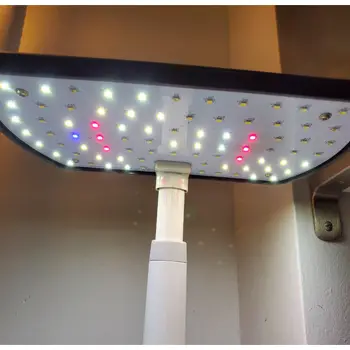Disclaimer
Hi, just letting you know that all products recommended here have been used by me, or are properly researched to ensure they are the best you are getting without bias.
I am also an affiliate for certain Amazon products and this means that some links here are affiliate links. If you purchase an item through any of them, I MAY earn a commission at no extra cost on you.
As indoor gardening continues to gain popularity, many people are turning to hydroponic systems like the Aerogarden for home-grown produce. These systems are designed to be user-friendly and efficient, with built-in grow lights that provide the necessary light spectrum for plants to thrive. However, with any type of indoor gardening, questions arise about the safety of the grow lights. Specifically, many people are concerned about whether Aerogarden grow lights are harmful to the eyes.
The human eye is a complex organ that is sensitive to light, and prolonged exposure to certain wavelengths can cause damage. This has led some to suggest that the blue and red LEDs used in Aerogarden grow lights could be harmful to the eyes. While there is no doubt that exposure to high levels of blue light can cause damage to the retina, the question remains as to whether Aerogarden grow lights pose a significant risk. Let’s find out.
Is exposure to aerogarden grow light harmful?
Are aerogarden grow lights bad for the eyes? This is a common question that many people who are using aerogarden systems ask. Aerogarden grow lights are designed to provide the necessary light spectrum that plants need to grow indoors. These lights are usually LED lights that emit blue and red light, which are the wavelengths that plants need the most. However, many people are concerned about the potential harmful effects of these lights on human eyes.
Studies have shown that exposure to high levels of blue light can damage the retina, the light-sensitive tissue at the back of the eye. This can lead to macular degeneration, a condition that can cause vision loss over time.
However, the amount of blue light emitted by aerogarden grow lights is relatively low and is not considered harmful to human eyes. In fact, the amount of blue light emitted by aerogarden grow lights is much less than the amount of blue light emitted by electronic devices such as smartphones and tablets.
That being said, it is still important to take precautions when you are working with aerogarden grow lights. You should avoid looking directly at the lights for extended periods of time and should always wear protective eyewear when working with the lights if you can.
Understanding light wavelength and intensity
One of the key factors to consider when evaluating whether the use of Aerogarden grow lights is bad for your eyes is understanding light wavelength and intensity.
Light is measured in wavelengths, with different wavelengths corresponding to different colors of light. The intensity of light is measured in lumens, with higher lumens indicating brighter light.
When it comes to Aerogarden grow lights, they emit a spectrum of light that is optimized for plant growth, which includes both blue and red wavelengths. While these lights are not considered harmful to human eyes in normal usage, it is important to use them as directed and avoid prolonged exposure to the light. Additionally, wearing protective eyewear when working with grow lights can further reduce any potential harm to your eyes.
Eye safety measures recommended by experts
While the Aerogarden grow lights are generally safe, it is important to take precautions to protect your eyes when using them. Here are three eye safety measures recommended by experts:
1. Wear protective eyewear:
When working around grow lights, it is important to wear protective eyewear such as safety glasses or goggles. These will protect your eyes from potential damage caused by exposure to UV rays and other harmful light wavelengths.
2. Avoid direct exposure:
While grow lights are designed to mimic natural sunlight, prolonged exposure to them can cause eye strain and fatigue. To avoid this, position the lights at a safe distance from your eyes and avoid looking directly at them.
3. Take regular breaks:
If you are working around grow lights for an extended period of time, it is important to take regular breaks to rest your eyes. This will help reduce eye strain and prevent long-term damage to your vision.
By following these eye safety measures, you can enjoy the benefits of grow lights without putting your eyes at risk. Remember, it is always better to be safe than sorry when it comes to protecting your vision.
Led grow light versus traditional grow light
While traditional grow lights have been used for years, many gardeners are now turning to LED grow lights due to their energy efficiency and longer lifespan. When it comes to eye safety, LED grow lights are generally considered safer than traditional grow lights. This is because LED lights emit less heat and UV radiation, which can cause eye damage over time. In addition, LED lights are more directional than traditional grow lights, which means they emit less light in all directions and more directly towards the plants. However, it is still recommended to wear protective eyewear when working with any type of grow light to avoid eye strain and potential damage.
Benefits of LED grow lights
While traditional grow lights emit a lot of heat and consume a lot of energy, LED grow lights offer an efficient and eco-friendly solution. In addition to being energy-efficient, LED grow lights offer numerous benefits for indoor gardeners. Here are a few benefits of the LED grow lights:
- Firstly, they are much cooler than traditional grow lights. This means that you can keep your plants closer to the light source without worrying about them overheating.
- Secondly, LED grow lights are much more efficient at converting electricity into light than traditional grow lights. This means that they use much less energy and produce less heat.
- Thirdly, LED grow lights can be customized to provide the exact spectrum of light that your plants need for optimal growth.
- Fourthly, they have a longer lifespan than traditional grow lights, which means that you won’t have to replace them as often.
- Finally, LED grow lights are much safer for your eyes than traditional grow lights, as they emit minimal UV radiation and are less likely to cause eye damage.
Conclusion
In conclusion, while there are concerns about the potential harm of aerogarden grow lights to your eyes, the evidence is inconclusive. It is important to take precautions when working with any kind of bright light, such as wearing protective eyewear or minimizing exposure time.
Also, choosing the right grow light for your aerogarden can make a difference in reducing the risk of eye damage. As with any health concern, it’s always best to consult with a medical professional if you have any concerns about your eyesight.



